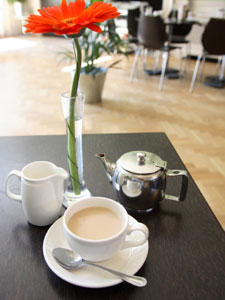Wholesaling Tea Pt 5: Food-service



The US Wholesale Tea Business is a fascinating niche business characterized by an incestuous supply chain and an irrational focus on everything BUT product quality. In this series I'll attempt to unpack a few basic truths about the wholesale tea business that every entrepreneur should learn before either becoming a tea wholesaler or buying from a wholesaler.
In Part 1 I covered the industry at a high level. In Part 2 I covered sourcing, storing and blending teas. Part 3 focused on sales to independent retailers and specialty shops. In Part 4 shared Adagio's experience with sales into Grocery and large retail channels. In this final section I will cover sales to food-service and hospitality operations.
The key word in this discussion is SMALL. Food-service and hospitality buyers are not purchasing a lot of tea. A busy restaurant might serve 20 cups of tea in a day. At 3 grams each that's about two pounds a month. Let's assume you buy in large quantities and are able to get your tea at $7.50 a pound. You sell it wholesale at $15 a pound. Your revenue is $30 a month from the restaurant with a net profit (not including shipping, storage, or any other overhead) of $15. Weigh the profit potential against the time and effort to land the account and most people would conclude that it's not worth even pursuing this business.
A medium-sized independent cafe ($500K in annual revenue) might sell 400 drinks a day. Even if 10% of those are tea based, total monthly consumption comes to about 8 pounds of tea. Using the numbers from above, your revenue would be $120, with net profits of $60 a month.
Of course there are cafes doing over $1 million a year, and there are chains upon which you could build a business with one account. The problem is that the larger buyers will either choose a distributor for convenience (Kehe, UNFI, Tree of Life, Sysco and others can serve a range of needs from tea and coffee to pastries and paper products), or they will buy from a national tea wholesaler for the best pricing.
Wholesaling to food-service is the classic chicken and egg conundrum. In order to build a profitable wholesale business you need to be able to land the large accounts. In order to land the large accounts you typically need an established wholesale operation with strong relationships and dramatic economies of scale.
Many new, small wholesalers invest significant amounts of time and money (mostly time) into landing small accounts or convincing existing businesses to start carrying higher quality teas. Once landed, the accounts head in one of two directions. Either tea will remain a small side business and therefore contribute little to the bottom line of the customer or wholesaler, or if tea really does take off, the wholesale customer will start paying closer attention to sourcing options and will find a supplier able to offer better pricing or service. Small wholesalers often absorb the majority of the development costs, and then lose out on the long term success.
The greatest benefit of establishing a base of food-service customers is often not profit but rather brand-building. A great way to establish a new tea brand in a local community is to land your teas in prominent restaurants, cafes, spas, hotels, etc. Even if you only cover your costs of service, getting your teas in front of area tea drinkers can have a powerful impact on building a loyal customer following and driving traffic back to your store or website.
If you choose to pursue this business, you'll run into a second chicken-and-egg challenge. Most food-service operations don't have the necessary tools to make good tea. They need water that is filtered and heated to the proper temperature, large filters for brewing loose tea, and either teapots or appropriate teacups. You'll find the majority of food-service buyers are currently using teabags and their water is tap water pulled from a coffee maker at 180 degrees. They don't sell much tea because they don't have good water at the right temperature. Because they don't sell much tea, they're hesitant to invest in a proper water boiler, filters and teaware. The best tea served in typical fashion at even a fine restaurant is mediocre at best.
Until restaurants and cafes are willing to invest in the proper equipment and procedures for preparing and serving tea, the customers will be unwilling to pay several dollars for a cup of quality loose tea. The key to overcoming this challenge often comes down to finding tea lovers or more forward-thinking entrepreneurs looking for a way to differentiate their business.
At the end of the day, wholesale tea sales into the food-service arena remains either the playground of large wholesalers with strong economies of scale, or a brand-building opportunity for local retailers.
Adagio Teas
Twitter: @AdagioRetail
